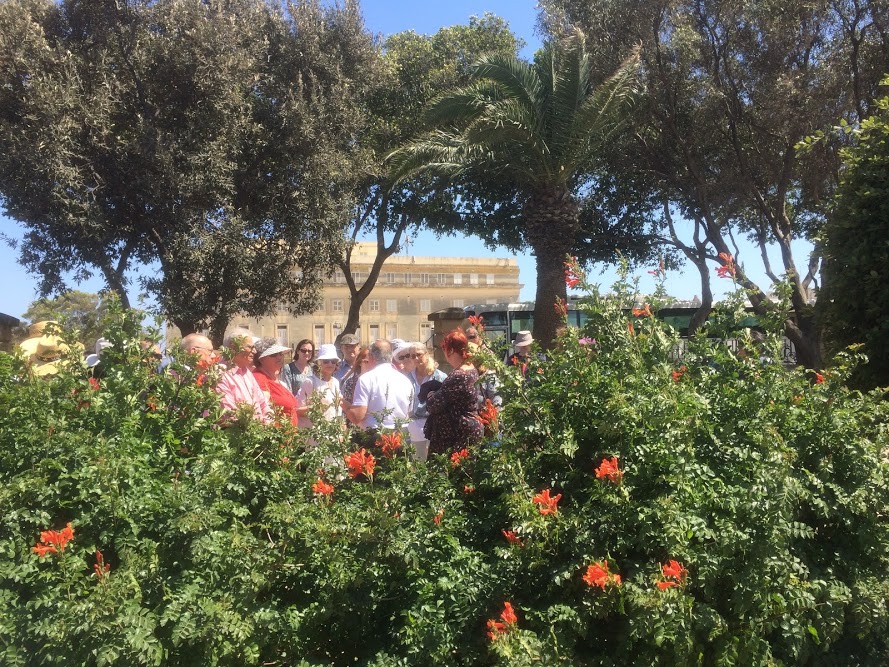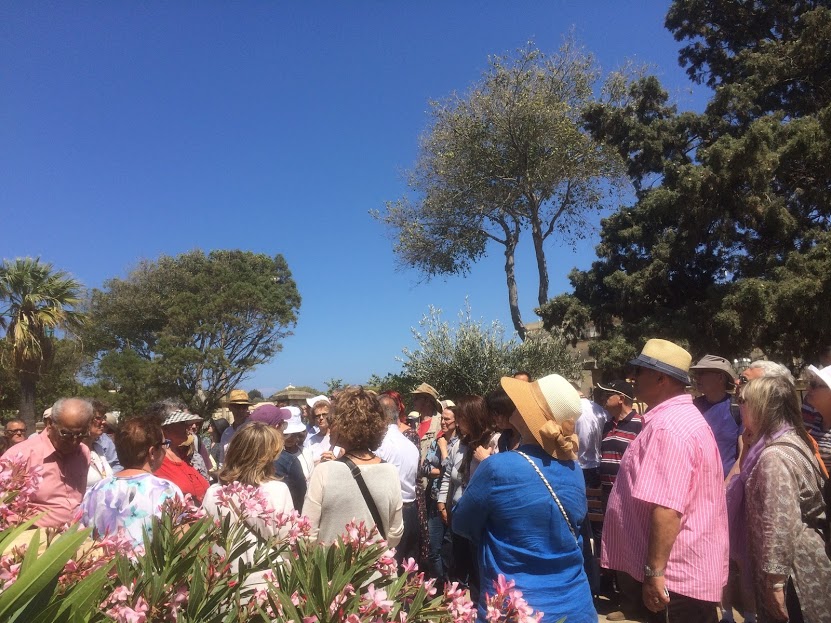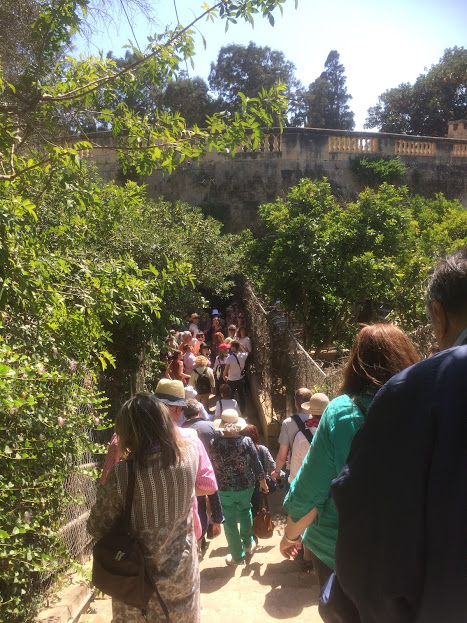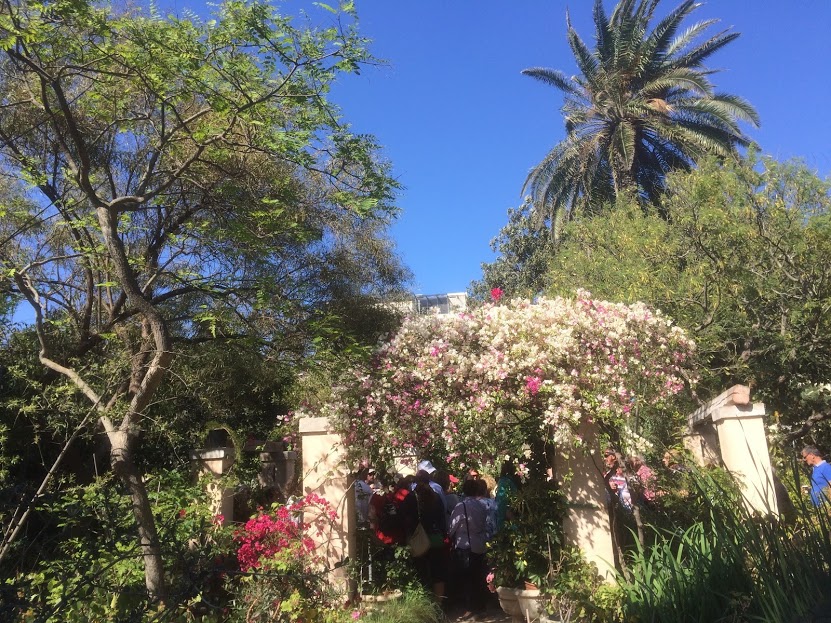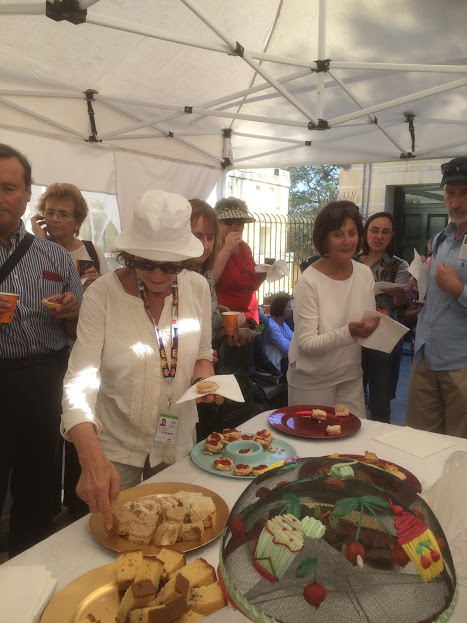Floriana’s Gardens Tour
Words & pictures with thanks to FAA members Wiebke Micallef Eynaud (tourist guide – [email protected]) and Maura Marlow respectively.
On Saturday 21st May members and supporters of Flimkien għal Ambjent Aħjar (FAA) were privileged to be given a tour of Floriana’s heritage gardens by Dr Joseph Buhagiar, the Director of Argotti Botanic Gardens and supported by Floriana Local Council.
The Mall Garden
Starting at the the Mall, Dr Buhagiar explained that the garden was built as a walled garden in 1656 under Grand Master Lascaris to provide a place where the knights of St John could exercise, for example by playing ‘Palla a Maglio’. In the first half of the 19th century, it served as a botanical garden but the garden remained walled until after World War II.
The Mall garden still contains a good number of interesting and unusual trees from the world’s regions which share a Mediterranean climate: California, Western Australia, South Africa, part of Chile and the Mediterranean itself. Amongst these are various palms, the Cow Itch Tree which originates from Australia and whose seed capsules have hairs that irritate the skin, a Cestrum shrub which produces fragrant white blossoms that attract night active fauna like moths, the Gleditsia triacanthos which grows three spikes on every node to protect itself, the Moreton Bay Fig, the Harpullia pendula which produces orange berries with shiny black seeds, the Sausage Tree which originates from Madagascar and the Brazilian Rosewood which produces yellow flowers.
Facing each other on either side of the path are an old Olive Tree and a Holm Oak, which despite all differences share the characteristic that the underside of their leaves is silvery in colour and covered with tiny hairs. This helps them reduce the loss of water.
The indigenous Sandarac Gum Tree (Għargħar), Malta’s national tree, has very hard wood – so strong that the Phoenicians used it to support mine shafts. Today it only grows in the wild in Malta and the western part of North Africa. Despite the small numbers in Malta, its genetic diversity is greatest here, a fact which points to thepossible past importation of seeds or specimens from various areas. It sheds branches to prevent loss of humidity. In the natural environment, these branches would then form a carpet which attracts fungi and would therefore supply moisture to the tree. The resin of the Sandarac Gum Tree can be used as varnish, and was in fact was used as part of the varnish mixture by Stradivari, the famous violin maker.
St Philip’s Garden
St Philip’s Garden was one of the gardens ’tal-Kmand’ which Sir Alexander Ball gave to the leaders of the insurrection against the French in order to ensure their ongoing loyalty. The entrance to the garden, an early 19th century opening in a wall that was built in the knights’ period, still houses the mechanism for the mechanically-operated gate . Nearby are the old underground railway station (to the left) and a magazine room for the storage of ammunition.
Steps lead up to the higher part of the garden with a large fountain which commemorates the early 17th century completion of the aqueduct and was originally positioned outside the Grand Master’s Palace at St George’s Square in Valletta. The fountain is now placed centrally in St Philip’s Garden, aligned with the Mall and Valletta City Gate.
Old water channels and stone troughs line the garden paths. The water used to be distributed through holes in the channels would be opened and closed using stone sluices when required, to water the soil in the respective areas of the garden after which the hole would be temporarily plugged. Then the wet soil would be covered with straw to prevent the loss of the precious water. Although this method of watering has fallen out of use it was very effective in ensuring that the soil was watered to a considerable depth, rather than just its surface as is the case with the now common drip irrigation.
Among the trees in this part of the garden are an Indian Bead Tree, Jacaranda and several species of succulent Euphorbias which are ‘self-watering’ because they attract water drops to form on their upturned branches and run down the branches to the stem.
Inner Argotti Garden
The whole of Argotti Garden was a University Garden until 1973. The Inner Garden alone was returned to the University in 1996. It holds, among other things, an impressive collection of cacti, which are kept in pots due to lack of space, and a Maltese Garden with a large number of endemic plants. Among them, the Maltese Salt Tree which has evolved to withstand salty sea spray. It stores potassium to counter the salty soil near the sea shore. The Maltese Everlasting with its almost white to silver grey foliage can withstand the great heat of summer in open unshaded areas like Dwejra Gozo.
The tour ended with a tea in Argotti Botanic Garden which was also hosting a plant-themed art exhibition at the time.
Learn more about Argotti Gardens here.
This event was supported by: Mizzi Motors, Dhalia Ltd, Da Vinci Hospital and Ecovis Malta.
